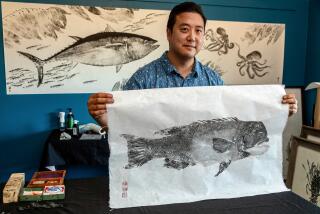Taxidermist can’t escape the wildlife
- Share via
Tom Kettles tried to retire from taxidermy, but his clients became unglued.
In 2005, he slid a “Closed” sign in the window of his log-cabin-style “wildlife studio.”
He meant to shutter his shop, Quality Taxidermy, but the sign sent people pounding on his door, pleading with him to immortalize their latest piece of prized game.
“Tom, you’ve been doing my stuff for years,” one said.
“You know how I like my animals,” said another.
Hunters are dedicated to their taxidermist -- it’s akin to having a favorite barber. And who can blame them? Taxidermy is a skill that involves a combination of painting, sculpting, a little bit of zoology and a heap of patience. Some pieces can take a year to finish.
For hunters, a mount serves as a memento of an exhilarating trip, or a trophy that speaks to high gaming skill.
“It’s dedication to the animal,” Kettles said. “You’re trying to honor the animal as much as you can.”
As the soft-spoken man with a leathery complexion stood in his sunny work space, which could be mistaken for a ceramics studio, he recalled his attempt to retire.
“They just kept coming,” said the 56-year-old, chuckling.
So now, he’s stuck packing the inner nostrils of an oryx with clay so they flare, painting black lines around a deer’s eyes to make them stand out, or patting mousse and gel over the coarse hair of a pronghorn antelope so it stands on end, just like it does in the northeastern plains of New Mexico.
Many of Kettles’ animals come from the mountain ranges of New Mexico or from the state’s steep mesas and desert canyons. It helps explain why some of the best taxidermists in the nation are in New Mexico, said Joel Edwards, president of the National Taxidermy Assn.
“Out here we got everything. We got antelope, we got moose, we got bison, we got mountain lion, we got bobcat, we got coyote,” said Edwards, a New Mexican who lives outside Hurley.
Rachel Poliquin, a taxidermy expert based in Vancouver, Canada, said that despite a negative public perception of the practice, hunters are animal lovers.
“They just express their love and enjoyment of the animal world in a way that doesn’t necessarily jibe with contemporary society much of the time,” said Poliquin, who is writing a book on the cultural history of the craft titled “Taxidermy and Longing.”
Kettles, like his customers, is an animal lover.
As a child, he raised pigeons and quails. When he was 10, he mounted his first bird, a sparrow hawk.
The mounting of the hawk was a solution: When birds died, he had trouble parting with them.
“I loved them so much, I couldn’t bring myself to dig a hole and throw them away,” he said.
After that first mount, Kettles took mail-order taxidermy courses. He opened his shop in the late 1980s.
Kettles takes pride in his artistic ability to recreate animal expressions, and he carefully studies books on how to draw and paint them.
For him, the key is precision.
So it’s no surprise that Kettles -- who doesn’t hunt -- is offended by joke mounts, such as dancing frogs, and considers it disrespectful when people hang baseball hats on the horns of an antelope.
With each animal, each hunter brings a tale.
“It reminds me of a kid coming home from school all excited,” Kettles said.
As a result, he has four freezers jam-packed with vacuum-sealed hides of bobcats, deer, antelope, elk, buffalo and pheasants. The chilly space, which is in the back of his main shop, is littered with cobwebs, and in the corner there’s bottle after bottle of every imaginable paint color.
He also has a friend, a blue and yellow macaw named Harley, so he doesn’t get lonely.
“I grew up with these, and these creatures are the ones I like,” said the burqueño -- as natives of Albuquerque are called -- standing in his showroom with a grizzly bear and two foxes.
Across the room, three javelinas, or wild pig-like creatures, look ready to eat anything that comes their way. Their mouths are wide open, exposing sets of sharp teeth.
Kettles said that this hunting season -- which started around August and ended last month -- had been particularly busy. He has more animals to mount this year than in each of the last 10 years.
So much for retirement.
nicole.santacruz@ latimes.com
More to Read
Sign up for Essential California
The most important California stories and recommendations in your inbox every morning.
You may occasionally receive promotional content from the Los Angeles Times.














